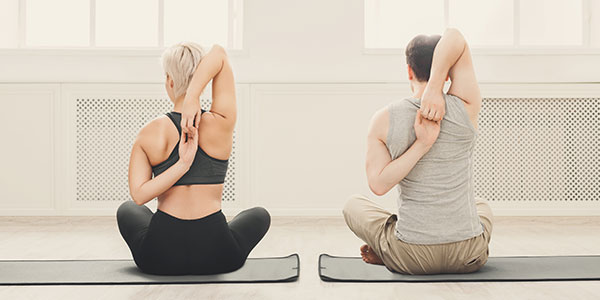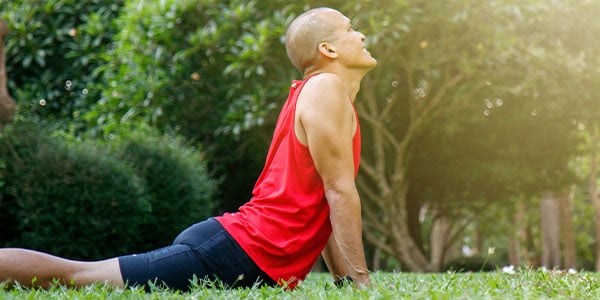As we are all currently practicing social distancing as best we can, several elements from our daily or weekly routine have fallen by the wayside. While it is still possible to work out at home, that regular rubdown that kept your muscles loose and minimised the effect of your workout on your body is now much harder to come by. As a result, there has been a sharp increase in complaints of general muscle soreness, as well as specific muscle group pain, such as neck pain and shoulder pain.
In this blog, we will discuss certain stretching exercises that can be performed as part of your workout to reduce the possibility of such complaints. We will address the main muscle groups that cause problems, such as the neck, shoulders, upper back back and lower back. While we have divided the exercises by muscle group for ease of reference, please remember that the muscles in your neck and shoulders are interconnected, as are the muscles in your shoulder and upper back. Therefore, an exercise that affects one tends to have an effect on the other as well, a fact that is important to keep in mind in case you are having trouble with one particular muscle group.
1. Neck Exercises: The best exercises to stretch the muscles in your neck are side rotations. To perform this exercise, simply ensure that your neck is placed squarely above your shoulders, and turn your head from side to side until you feel a stretch in your neck and shoulders. Once you feel the stretch, maintain the position for 15-30 seconds (depending on your comfort level) before turning to the other side and repeating the exercises. Please note that doing neck rotations can be couterproductive, as studies have shown that neck rotations compress cervical nerves, compounding the problem rather than fixing it.
 2. Shoulder Exercises: One of the best exercises you can do for your shoulder is the cross-body shoulder stretch. This exercise requires you to be standing with your feet hip-wide, before stretching one arm out straight and bringing it across your body. Use the other arm to hook the first arm by bending it at the elbow, using the forearm of the second arm to stretch the first arm further into your body until you feel pressure in your muscles. Hold the pose for 15-30 seconds (depending on your comfort level) before repeating the exercise on the other side.
2. Shoulder Exercises: One of the best exercises you can do for your shoulder is the cross-body shoulder stretch. This exercise requires you to be standing with your feet hip-wide, before stretching one arm out straight and bringing it across your body. Use the other arm to hook the first arm by bending it at the elbow, using the forearm of the second arm to stretch the first arm further into your body until you feel pressure in your muscles. Hold the pose for 15-30 seconds (depending on your comfort level) before repeating the exercise on the other side.
 3. Upper Back Exercises: A great stretching exercise for your upper back is gomukhasana. To perform this exercise, stand with your feet hip-width apart, reaching straight up with one arm before bending it at the elbow and bringing it back down behind your head. Stretch the other arm towards the ground before bending it at the elbow and reaching up behind your back. Interlock your hands behind your back and maintain the pose, taking 5-10 deep breaths.
3. Upper Back Exercises: A great stretching exercise for your upper back is gomukhasana. To perform this exercise, stand with your feet hip-width apart, reaching straight up with one arm before bending it at the elbow and bringing it back down behind your head. Stretch the other arm towards the ground before bending it at the elbow and reaching up behind your back. Interlock your hands behind your back and maintain the pose, taking 5-10 deep breaths.
 4. Lower Back Exercises: One of the best exercises for you lower back is the prone bridging stretch. In order to perform this exercise, lie flat on your stomach. Use your arms to prop yourself up until your arms are extended to the point where your elbow is straight, and hold the pose. There are two very important points to note with this exercise. The first is that the gap between your hands must be the same as the width of your shoulders. Further, in case you feel pressure in the muscles in your back prior to the arms being completely extended, do not stretch it any further. Build flexibility in your muscles over time, as flexibility is about daily incremental gains rather than pushing yourself past your limits.
4. Lower Back Exercises: One of the best exercises for you lower back is the prone bridging stretch. In order to perform this exercise, lie flat on your stomach. Use your arms to prop yourself up until your arms are extended to the point where your elbow is straight, and hold the pose. There are two very important points to note with this exercise. The first is that the gap between your hands must be the same as the width of your shoulders. Further, in case you feel pressure in the muscles in your back prior to the arms being completely extended, do not stretch it any further. Build flexibility in your muscles over time, as flexibility is about daily incremental gains rather than pushing yourself past your limits.
It is critical to remember that as these are stretching exercises, you must try and do them slowly, stretching your muscles as much as possible at each point, in order to achieve the best results. Concentrate on the sensations provided by the muscle at each point to identify any points during the exercise where the stress on the muscle appears to be greatest. Building muscle flexibility is a gradual process, but one that will stand you in good stead for the future as it helps alleviate pain, as well as minimising the risk of injury in the future.



























